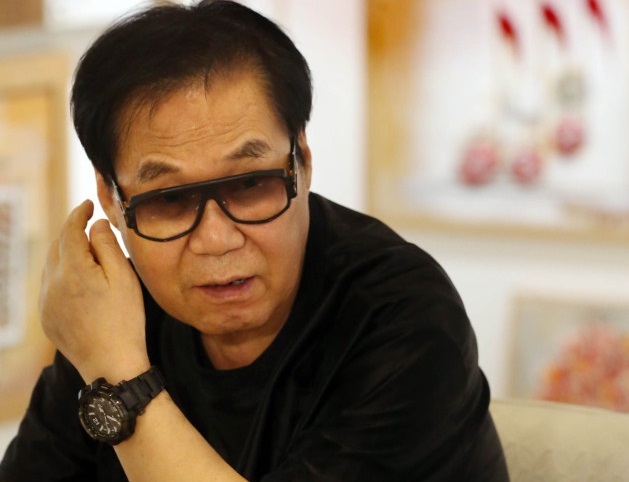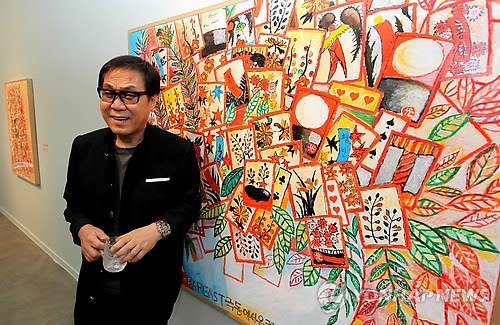Fraud or common practice?
Singer-artist Cho Young-nam’s ghost painter stirs debate on using assistants in art making
By KH디지털2Published : May 23, 2016 - 15:25
If a painting displayed in a gallery was not painted by the artist who signed it, what are viewers to make of it?
Such is the controversy that currently surrounds celebrity singer and painter Cho Young-nam, who is in hot water over allegations he hired a ghost painter to create his works for about seven years.
In face of mounting criticism, Cho canceled his concerts and a solo gallery exhibition scheduled to open last week.
Last Monday, a 61-year-old painter surnamed Song claimed he had painted more than 300 of Cho’s painting since 2009. Song filed a case with the Chuncheon Supreme Prosecutors’ Office, which then raided Cho’s office and galleries that have been dealing his works to gather evidence that may prove the charge of fraud against him.
Amid the growing disappointment and shock among his fans and the public, Cho admitted he hired three or four assistants when he was busy, but insisted the original ideas for his paintings were “100 percent” his, in an interview with Yonhap News Agency on May 17.
Such is the controversy that currently surrounds celebrity singer and painter Cho Young-nam, who is in hot water over allegations he hired a ghost painter to create his works for about seven years.
In face of mounting criticism, Cho canceled his concerts and a solo gallery exhibition scheduled to open last week.
Last Monday, a 61-year-old painter surnamed Song claimed he had painted more than 300 of Cho’s painting since 2009. Song filed a case with the Chuncheon Supreme Prosecutors’ Office, which then raided Cho’s office and galleries that have been dealing his works to gather evidence that may prove the charge of fraud against him.
Amid the growing disappointment and shock among his fans and the public, Cho admitted he hired three or four assistants when he was busy, but insisted the original ideas for his paintings were “100 percent” his, in an interview with Yonhap News Agency on May 17.

“I worked with my assistant for paintings that were especially loved by viewers when I was holding exhibitions every six months. I admit that I used the skills of my assistant for some of my ‘hwatu’ (Korean card game) paintings,” Cho was quoted as saying.
Cho, 71, who is also a popular singer, radio show host and television personality, has been painting and holding exhibitions since the 1970s. He held his first solo show in Seoul in 1973 and has held numerous group and solo exhibitions in Japan, New York and Washington.
Cho is known for paintings that feature motifs representing Korean and Western cultures, such as the Korean folk card game hwatu images and Coca-Cola logos. A painting that measures 130 by 97 centimeters was priced at around 30 million won ($25,300) at a recent art fair in Seoul. Song claimed to have received 100,000 won per painting on average.
Despite the criticism of Cho, some art critics argue that using assistants is a standard practice in contemporary art.
A poll released by Real Meter last Thursday showed that 73.8 percent of 501 respondents aged 19 and above thought selling or displaying paintings without revealing they were mostly done by assistants constitutes fraud, while 13.7 percent considered it a common practice in the art world.
“I don’t think Cho should be criticized in this case. A lot of living contemporary artists hire assistants and most of their works are completed by their assistants,” art critic Ban Yi-jeong, wrote via his blog.

Well-known contemporary artists such as Jeff Koons and Damien Hirst are known to openly employ assistants who work in the artists’ large studios on their paintings, sculptures and installations. Pop art icon Andy Warhol also produced his silkscreens and lithographs at his New York studio with the help of assistants and workers.
Celebrated art critic and professor Jin Joong-kwon said via Twitter and in a newspaper column that the public’s outrage is due to their “lack of knowledge of contemporary art.”
“Since pop art, it has become standard practice for artists to have others finish their works based on the concept they provided them,” wrote Jin in his May 18 column for a daily.
Other art critics, however, argue that the types of paintings produced by Cho do not require the skillful hands of assistants.
“Assistants are not there to help with the parts that anyone can do. They are needed when artists struggle to find ways to produce their works in ways that they are not familiar with, such as complex technologies needed in media art,” said art critic Chung Joon-mo, in a phone interview with The Korea Herald.
Media artist Nam June Paik was known to have worked with several technicians for many years to realize his unexplored concepts in media art and produce progressive multimedia works.
Art critic Gim Jun-gi characterized Cho’s use of assistants as “outsourcing.”
“Usually artists and their assistants work in the same studio. But in Cho’s case, Cho outsourced his painting to another artist who was not working in Cho’s studio,” said Gim in a phone interview. “Paying him 100,000 won per piece was too stingy,” Gim added.
While the prosecutor’s investigation is still underway, art critics said judging what Cho has done as an artist within the legal framework would be hard considering the emotional and abstract aspects of making art.
“It would be hard for prosecutors to confirm to what extent Cho was involved in creating his paintings and how much of his involvement was decisive enough to make his work his own creations,” said critic Chung.
By Lee Woo-young (wylee@heraldcorp.com)






![[From the Scene] Monks, Buddhists hail return of remains of Buddhas](http://res.heraldm.com/phpwas/restmb_idxmake.php?idx=644&simg=/content/image/2024/04/19/20240419050617_0.jpg&u=20240419175937)




![[Graphic News] French bulldog most popular breed in US, Maltese most popular in Korea](http://res.heraldm.com/phpwas/restmb_idxmake.php?idx=644&simg=/content/image/2024/04/18/20240418050864_0.gif&u=)



![[From the Scene] Monks, Buddhists hail return of remains of Buddhas](http://res.heraldm.com/phpwas/restmb_idxmake.php?idx=652&simg=/content/image/2024/04/19/20240419050617_0.jpg&u=20240419175937)

![[KH Explains] Hyundai's full hybrid edge to pay off amid slow transition to pure EVs](http://res.heraldm.com/phpwas/restmb_idxmake.php?idx=652&simg=/content/image/2024/04/18/20240418050645_0.jpg&u=20240419100350)

![[Today’s K-pop] Illit drops debut single remix](http://res.heraldm.com/phpwas/restmb_idxmake.php?idx=642&simg=/content/image/2024/04/19/20240419050612_0.jpg&u=)